
I’ve always said characters are the gateways into stories. It turns out, they’re also the gateways into fighting games. If no one interests you, you have no reason to play.
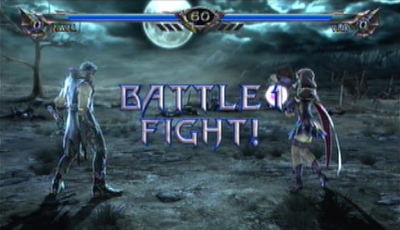
It blows my mind that the same team who produced the undisputed shittiest SoulCalibur character designs could, in the very same game, give us the series’ most awe-inspiring, beautiful, and atmospheric stages.
Review by Jay Wilson SoulCalibur is dead. It’s been coming for awhile. Like a seemingly harmless cough, no one recognized SoulCalibur II’s console exclusive guest characters for what they were: the first signs of a fatal illness. It grew worse with SoulCalibur III’s overabundance of pointless single player mini-games at the expense of the core fighting engine; it seemed to get better with SoulCalibur IV’s improved gameplay but the cough lingered with the glaring inclusion of Star Wars characters. And now the series has produced not only a game I dislike, but one I absolutely despise with every creative fiber in my being. Let’s start with the story mode, which I normally wouldn’t do for a fighting game, but there’s some threads here that run through every aspect of SCV. While a few select scenes are told with cut scenes using the game’s actual 3D models, most of SoulCalibur V’s narrative is told with static hand drawn pictures while voice actors read their respective parts over a backdrop of sound effects—an effort that feels half-hearted and lazy. And, to sum up the story, the new protagonists, Patroklos and Pyrrha, whine nonstop while a parade of main characters who happen to be walking by in the most unlikely of places lead them to the Soul swords. Listening to Patroklos and Pyrrha cry while the sounds of battle rage and a glorified slide show plays in front of me, I can’t help but feel like I’m looking at refrigerator drawings while children scream in the next room. I never realized how much I appreciated old school arcade fighting games that didn’t even bother with a story mode until I played SCV. The game takes place seventeen years after SoulCalibur IV which is just a gimmick to make the game appear more different than it actually is. In theory, old characters age, die, and retire, making room for new characters. In SCV, though, most returning veteran characters have not aged, and the two that did (Mitsurugi and Siegfried), Namco half-heartedly and lazily just tacked a beard onto the old face. As expected, Astaroth (a golem) and Yoshimitsu (a masked warrior) were technically replaced by Astaroth 2.0 and Yoshimitsu the Second but for all practical purposes they might as well be the originals. As for the truly dropped characters, new ones step in to fill their shoes including Natsu, an apprentice who replaces Taki while retaining her updated (mutilated) moveset; Leixia replaces her mother, Xianghua; Pyrrha replaces her mother, Sophitia; Xiba replaces Kilik. This yields five, ahem, “new” characters who do something SoulCalibur IV’s characters already did. And when you consider had Namco stuck with the original cast, they’d have updated their moveset and given them new outfits anyway these “new” characters amount to label changes. Like I said, an illusion of change without real change (ie, half-hearted and lazy “change”.) 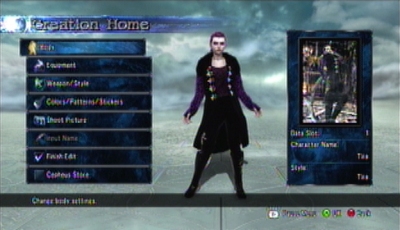
One could argue that with such an excellent Creation Mode I should just make my own characters and enjoy SCV. But why the hell should I pay Namco money to do their job for them?
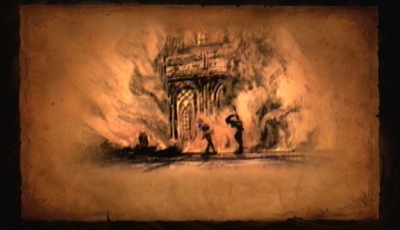
Normally, I don’t care how stupid a fighting game’s plot is. But with SCV, I learned that if presented annoyingly enough, I can rage against every gimmicky, juvenile, and moronic plot twist that keeps the nails-on-a-chalkboard, ahem, “cinematic” going.

Notice the numbered meter at the end of the life bar. Among other options, it allows characters to perform powered up “Brave Edge” versions of normal moves.
Making matters worse, the game offers two versions of Patroklos and two versions of Pyrrha so, in essence, two characters take up four slots on the character select screen (in Namco’s defense, the alpha and omega versions do play differently.) And making the roster completely unforgiveable: SoulCalibur V has not one, not two, but three mimics. What is a mimic? A mimic is a character who doesn’t have his own moveset; like their name implies, mimics copy the fighting styles of existing characters and use that instead. In other words, Game director Daishi Odashima put three separate characters on the character select screen and didn’t bother giving them their own fighting styles. And the sadly comical icing on this half baked cake of insults? Tekken’s Devil Jin makes an appearance in SoulCalibur V ... sorta. More accurately: his fighting style makes an appearance, but there’s no character assigned to it. You have to go and make your own character to use this style. I take personal offense to the notion that Namco expects me to buy their incomplete game only to finish it for them. If that’s not lazy and half-hearted, I don’t know what is. Now while I adore the Soul series and have played it since Soul Edge/Blade in arcades, I won’t pretend it represents the paradigm of great character design. And over the years more and more characters I truly dislike have slowly infiltrated the roster. In fact, the now legendary SoulCalibur II introduced some of my least favorite characters—Cassandra, Yun-Seong, and Talim. Their animations, their win poses, their battle quotes and voice actors always kept me from picking them up even if their styles seemed mildly interesting. Two games later, I didn’t even like fighting against them, so I never ever dreamed I would actually miss them. But, you know what? SoulCalibur V has character designs so terrible Uwe Boll, himself, would shudder in disgust. The new characters repulsed me so much, I didn’t even want to use them as practice dummies to learn how to fight against them. Furthermore, I’m glad Taki, my favorite character, is not in this game with these abominations. Pyrrha not only spends all of story mode whining, she whines before and after every battle. In one of her victory poses, she collapses into a ball and weeps. In another, she actually runs away crying. Hell, one of her intros shows her backing up shaking her head like a cornered puppy. I appreciate vulnerable protagonists, but good Lord, I’m not convinced this woman could wake up and make the journey down the hall to the bathroom without a night light. Patroklos is mildly better since he swings back and forth between unbearable whiner and overconfident self-righteous pretty boy prick. Xiba apparently suffers from extreme famine as he obsesses over food before and after each battle, and yet he has the strength to fight it out with powerful warriors; he inherited Kilik’s old staff style and promptly bastardized it into monkey-boy with a stick antics. And Natsu is the annoying cheerleader archetype that appears in every single movie and television show ever made. Light hearted joke characters are fine, but they’re not supposed to take over the entire cast. 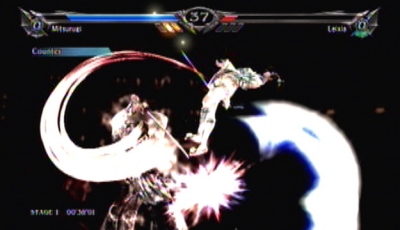
With a full meter, a character may execute a flashy super move called a “Critical Edge.” At least they seem to go by faster than MK9's XRays ... or maybe I just didn‘ notice because SCV has bigger problems.
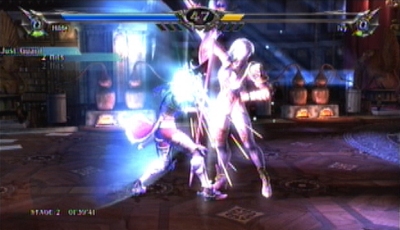
SCV introduces a new mechanic called “Just Guard” executed by tapping guard when an incoming attack is about to land. It neutralizes the attack and slows down the attacker’s combo, creating a small window for the defender to retaliate.

Guard Impacts now cost meter, meaning a whiffed GI not only leaves you open to heavy damage but also wastes finite resources. On the flip side, the new GIs catch high, medium, and low attacks, neutralizing mixups.
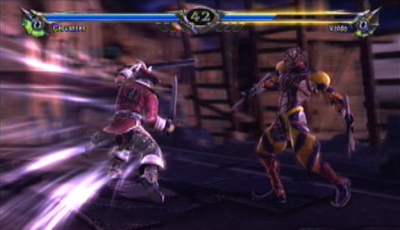
Notice the white air trails on Cervantes. SoulCalibur has had side-stepping for awhile, but V improves it and even gives it a new name: “Quick Moves.”
Then there’s Z.W.E.I. who might be the biggest collection of rip offs in gaming history—Rickimaru’s hair, Zasalamel’s collar, Maxi’s open jacket, David Bowie’s leather pants, the list goes on forever. There’s also Viola, a supposedly new character with amnesia, who suspiciously looks exactly like an aged Amy from SoulCalibur III & IV. Both feel out of place thanks to their more fantasy-driven fighting styles: Z.W.E.I. summons a spiritual companion (named Ein) to fight with him, and Viola wields a clawed glove and sends her magic floating crystal ball after her opponents. Neither the SoulCalibur cast nor their weapons have ever been realistic, but this time around I get the impression the designers ran out of inspiration from real world weapons and turned to Dungeons and Dragons. But, then again, maybe I’m expecting too much from the people who literally named a character after a euphemism for excrement. If this cast is the future of SoulCalibur, I’m content never playing the series again. Fighting games are most fun when the gameplay encourages a balance of offense and defense, and nothing sucks the life out of these games like an engine that favors excess in either direction. SCV removes Critical Finishes but retains a disincentive for excessive defense (aka, turtling) in that eventually their lifebar will flash yellow then red and then their guard will break. The careless defender will be temporarily stunned allowing the aggressor to unleash the combo of their choice, and, with SCV’s high damage plus the addition of the new meter putting Brave Edge (powered up normal moves) and Critical Edges (super moves) at their disposal, the consequences to turtling could still very well be round-ending dire. And to combat excessive offense, Just Guards and Guard Impacts allow the attentive player to neutralize or repel (predictable) incoming attacks and return fire, plus Quick Moves (buffed up side stepping) allows the same player to avoid linear (predictable) attacks. So at its most core level, the SCV system has great potential. But to engage a fighting game’s system, you need to use a character and that’s where things break down for me. SoulCalibur V further reduces the move lists from its already streamlined predecessor’s to the point that I feel I no longer have options. For example, in SoulCalibur IV Mitsurugi had two stances: Mist and Relic. In Mist, among many options you could perform a double uppercut (now gone) or you could do a single uppercut and transition into Relic (also gone) and then juggle them. For me, much of the fun came from this Mist/Relic combo, not to mention the 50/50 games that Relic allowed where he could kick low or sidestep and slash forcing his opponent to guess where to place their defense. Mitsurugi also had a horizontal slash (Feint L) and a hopping vertical slash (Obedience) with Just Input variations. Basically, if you performed these moves fast enough, it would come out faster, do more damage, and be accompanied by a white flash. In essence, the game rewarded the player for dexterity and skillful execution. SoulCalibur V removes the just input versions (but retains the vanilla non-just originals), and now executing these moves feels so ... pedestrian. Mitsurugi has gained a few new tricks, but all of my reasons for playing him are gone. Namco replaced my other character with the terrible terrible terrible Natsu who is the oh-em-gee-ified mangled regurgitation of Taki’s less than thrilling original design. But getting over the sheer crap of this new brat’s aesthetics, many of Natsu’s updates to Taki’s style feel arbitrary and unnatural. In SoulCalibur, changes to inputs isn’t anything new, but in the past they made sense. The game uses four buttons: Horizontal Slash, Vertical Slash, Guard, and Kick. Often times moves don’t fit snugly into one of those categories (such as Stalker which makes Taki jump so she can attack midair); thus the first SoulCalibur games assigned these miscellaneous moves random button combinations (in Stalker’s case, both slash buttons). Starting with SoulCalibur III, they started applying a “best fit” approach. There may not be a jump button (or combination of buttons), but it kinda makes sense to push kick since Taki has to use her legs for both kicking and jumping so it changed to Horizontal Slash+Kick. And that’s fine. I welcome change for a logical reason. But Natsu in SoulCalibur V changes inputs for the sole sake of changing inputs ... and since most inputs are accounted for, this means a complete reshuffling of the most basic moves. 
Even if you make your own custom characters, these pieces of shit would still ruin them because you’d still have to watch their fucking retarded intro animations and victory poses.
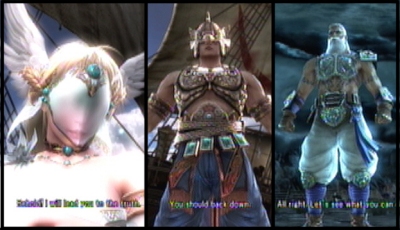
This is what’s called blatant padding—adding content that is essentially meaningless to inflate something’s worth. And SoulCalibur V has crossed the threshold of having more filler than actual substance.
Furthermore, Taki used to have whole combo trees that would go from horizontal slashes to vertical slashes (and vice versa) preventing her opponents from sidestepping or ducking. Natsu does not. Taki had two very limiting teleports; Natsu teleports all over the place. On the plus side, some of them seem to serve as a way of cancelling moves for mind games which Taki desperately needed in SCIV; on the down side, Natsu’s constant appearing/disappearing comes across as a visual gimmick whored beyond the extreme of taste and gets old really fast. The one thing I liked about Natsu is that her Shadow Shrine just input is not prohibitively difficult like Taki’s was. I’ve played a number of a secondary characters through the years and goofed around with everyone in every game. So, I gave the entire cast of SCV a fair shot, and the only characters that appealed to me were Aeon (Lizardman) and Tira. In SCIV, Lizardman was another shield character in a game with two already, and dimming my enthusiasm further his flow of attacks felt terribly unnatural and counterintuitive. And Tira, of course, was bottom of the barrel in terms of power, making her notoriously difficult to win with; it also meant she really couldn’t get any worse. It’s a bit telling that the only characters I remotely liked are the ones who didn’t have anything to lose. | ||||||||||||||||||||
|
| ||||||||||||||||||||
